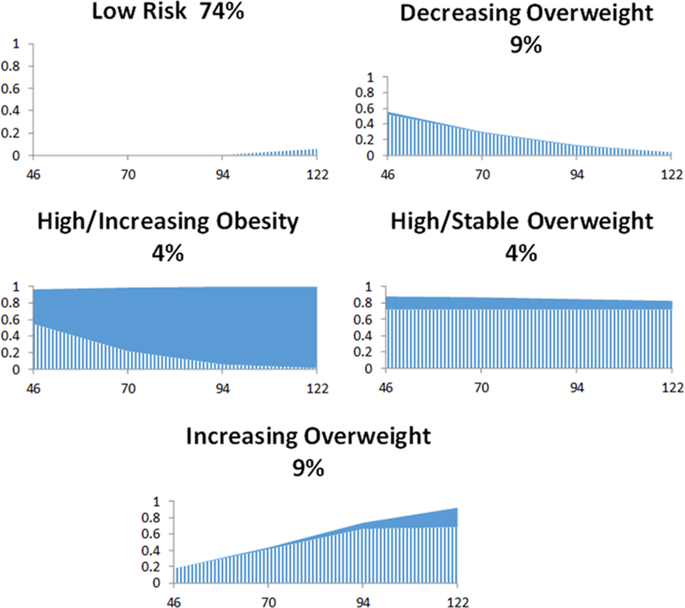International Journal of Obesity ( IF 4.2 ) Pub Date : 2019-12-11 , DOI: 10.1038/s41366-019-0502-1 Alison Parkes 1 , Michael Green 1 , Anna Pearce 1

|
Objective
To investigate how mealtime setting, mealtime interaction and bedroom screens are associated with different trajectories of child overweight and obesity, using a population sample.
Methods
Growth mixture modelling used data from children in the Growing Up in Scotland Study born in 2004/5 (boys n = 2085, girls n = 1991) to identify trajectories of overweight or obesity across four time points, from 46 to 122 months. Using data from children present at all sweeps, and combining sexes (n = 2810), mutually adjusted associations between primary exposures (mealtime setting, mealtime interaction and bedroom screens) and trajectory class were explored in multinomial models; controlling for early life factors, household organisation and routines, and children’s diet patterns, overall screen use, physical activity and sleep.
Results
Five trajectories were identified in both sexes: Low Risk (68% of sample), Decreasing Overweight (9%), Increasing Overweight (12%), High/Stable Overweight (6%) and High/Increasing Obesity (5%). Compared with the Low Risk trajectory, High/Increasing Obesity and High/Stable Overweight trajectories were characterised by early increases in bedroom screen access (respective relative risk ratios (RRR) and 95% confidence intervals: 2.55 [1.30–5.00]; 1.62 [1.01–2.57]). An informal meal setting (involving mealtime screen use, not eating in a dining area and not sitting at a table) characterised the High/Increasing Obesity and Increasing Overweight trajectories (respective RRRs compared with Low Risk trajectory: 3.67 [1.99–6.77]; 1.75 [1.17–2.62]). Positive mealtime interaction was associated with membership of the Increasing Overweight trajectory (RRR 1.64 [1.13–2.36]).
Conclusion
Bedroom screen access and informal mealtime environments were associated with higher-risk overweight and obesity trajectories in a representative sample of Scottish children, after adjusting for a wide range of confounders. Findings may challenge the notion that positive mealtime interaction is protective. Promoting mealtimes in a screen-free dining area and removing screens from bedrooms may help combat childhood obesity.
中文翻译:

卧室屏幕和用餐环境会塑造儿童超重和肥胖的不同轨迹吗?使用苏格兰成长研究的研究。
客观的
使用人口样本调查用餐时间设置、用餐时间互动和卧室屏幕如何与儿童超重和肥胖的不同轨迹相关联。
方法
生长混合模型使用来自 2004/5 年出生的苏格兰成长研究中的儿童(男孩n = 2085,女孩n = 1991)的数据来确定从 46 到 122 个月的四个时间点的超重或肥胖轨迹。使用来自所有扫描中的儿童的数据,并结合性别(n = 2810),在多项模型中探索了主要暴露(进餐时间设置、进餐时间互动和卧室屏幕)和轨迹类别之间相互调整的关联;控制早期生活因素、家庭组织和日常活动,以及儿童的饮食模式、整体屏幕使用、身体活动和睡眠。
结果
在两性中确定了五个轨迹:低风险(68% 的样本)、减少超重(9%)、增加超重(12%)、高/稳定超重(6%)和高/增加肥胖(5%)。与低风险轨迹相比,高/增加肥胖和高/稳定超重轨迹的特点是卧室屏幕访问的早期增加(各自的相对风险比 (RRR) 和 95% 置信区间:2.55 [1.30–5.00];1.62 [1.01] –2.57])。非正式的用餐环境(包括用餐时间屏幕使用、不在用餐区用餐和不坐在餐桌旁)以高/增加肥胖和增加超重轨迹为特征(与低风险轨迹相比,各自的 RRR:3.67 [1.99–6.77];1.75 [1.17-2.62])。积极的进餐时间互动与增加超重轨迹 (RRR 1.
结论
在调整了广泛的混杂因素后,卧室屏幕访问和非正式进餐环境与苏格兰儿童代表性样本中较高风险的超重和肥胖轨迹相关。研究结果可能会挑战积极的进餐时间互动具有保护作用的观点。在无屏幕用餐区促进用餐时间并从卧室移除屏幕可能有助于对抗儿童肥胖。











































 京公网安备 11010802027423号
京公网安备 11010802027423号